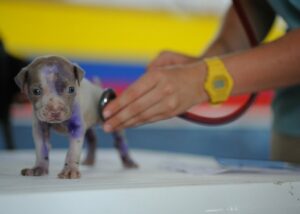Teaching dogs tricks is usually limited to fairly basic tasks, like sit, roll over, or jump. Every once in a while though, you see a dog that has mastered a particularly impressive trick. One of these is to teach your dog to ride a skateboard. Typically it looks like these dogs are just very talented, but teaching a dog to ride a skateboard is doable. It is difficult and not every dog will have the attention span to do it. However, if you and your dog are content to spend a while trying out new things, you might be able to train your dog to skateboard!
These types of advanced tricks aren’t for every dog. You need a dog that really enjoys the intellectual stimulation of learning new tricks. Equally, they have to be open to actually doing something like riding a skateboard! While you can’t exactly ask them, a dog that prefers to nap than to play might not be particularly keen on the idea. This what you need to know to train a dog to ride a skateboard:
What Dogs Can Learn to Ride a Skateboard?
Riding a skateboard is a fairly advanced trick! Not every dog is going to be able to master it. Before you start with the training, it might be worthwhile to consider if this trick is right for your dog. These are some of the factors you need to consider:
- Can They Physically Do It? – This is probably the most important and obvious factor. Not every dog can physically ride a skateboard. They might be too small to comfortably move the board, or not be built to push with one leg. Some dog’s legs might be tall so they struggle to balance while pushing. Even if your dog is one of the healthiest breeds, this trick requires specific physical builds. They need to be able to push with their back legs, while standing comfortably.
- Do They Like Long Training Projects? – This is a lengthy process for training your dog. If you want them to learn how to ride a skateboard, you need to know it will sustain your dog’s attention in the long-term.
- Are They Happy to Move on it? – Some particularly anxious dogs might not enjoy the sensation of riding on a skateboard. If your dog isn’t getting accustomed to it during training, it might not be a good fit for them. Equally some dogs just hate the feel of grip tape under their feet. If your dog has a complete aversion to standing or moving on the board, then it might not work.
It is worth trying your dog out with a skateboard if you’re unsure. However, some of these things like their physical build might make the process impossible.
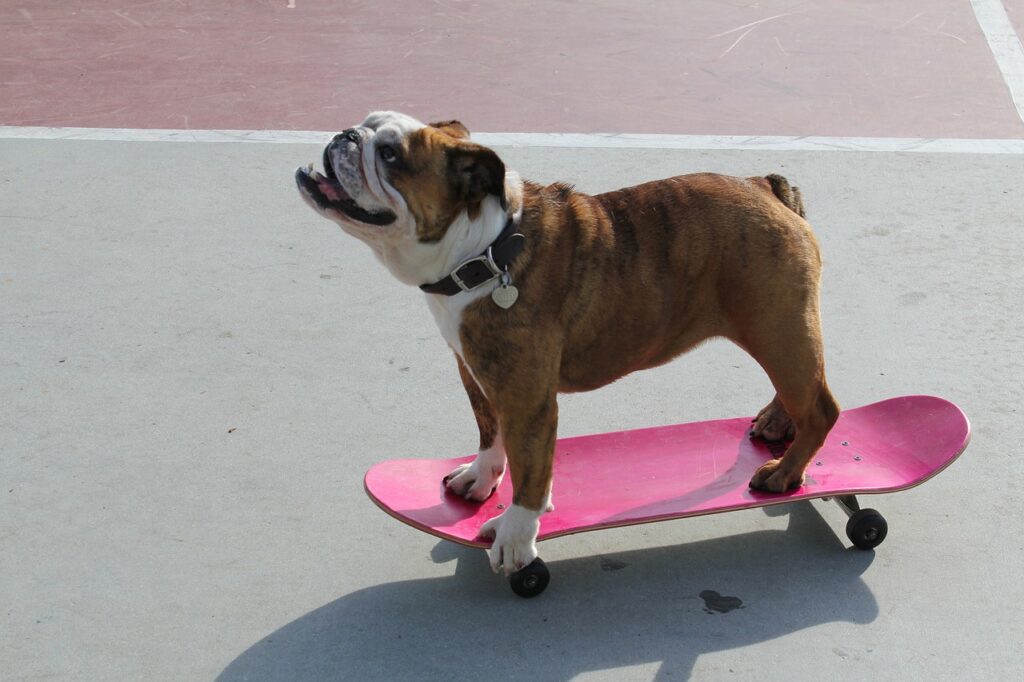
How to Train Your Dog to Ride a Skateboard
Training your dog to ride a skateboard can be a long process. If you think you and your dog are up for it though, then this is the rough method you can follow:
Start with a Stationary Skateboard
To begin with, you’re going to need to use a stationary skateboard. To make sure the board is secure, you can place it somewhere that keeps the wheels in place. This can be by physically putting something around them to hold it steady. Alternatively though, some rough grass or a rug can work fine too. The dog needs to see the skateboard with any moving parts at first.
Have the skateboard around and allow your dog to get used to its presence. This will make it less weird for them when they begin to interact with it.
Get Them Interested
The next step is to get your dog actually interested in the skateboard! Get your dog to place a paw or two on the board. Whenever they interact with it, give them a reward and lots of praise! As time passes, your dog should begin to feel more positive about the skateboard and about interacting with it. If your dog climbs onto the skateboard of their own accord, you should give them a lot of praise!
Start to Move the Board
The next step is to get the dog used to the idea of the skateboard moving! This isn’t a particularly long step. All you really need to do is ensure your dog understands that the skateboard can move. If they don’t see the board move, they will be startled when it does. This teaches them to expect the skateboard to move once they’re on it.
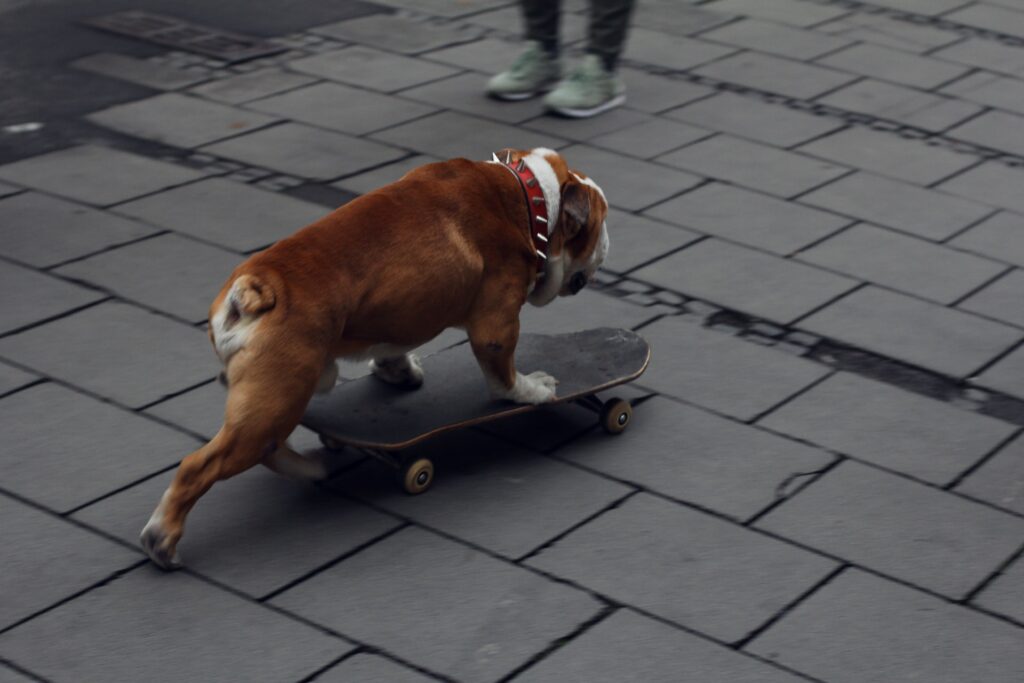
Get Him to Stand on the Board
This is where things start to get a bit more interesting! Try to get your dog to stand on the skateboard. When they do, give them the usual praise and treats for a job well done. You shouldn’t try to move the board, just get them used to the idea of standing on one.
Move the Board
Once your dog is happy to stand on the skateboard, you need to introduce the moving part. This one might take a while, since it can feel unnatural for your pet. Start this step once they’re comfortable with standing on the board and are relaxed. With them on it, gently push the skateboard forward.
The first few times, your dog will likely step down or steady themselves. In this stage, give them a lot of positive reinforcement. Encourage them to comfortably stay on the board while it moves. This will take a while to perfect. Make sure you hold the board stably so your dog doesn’t fall off during this!
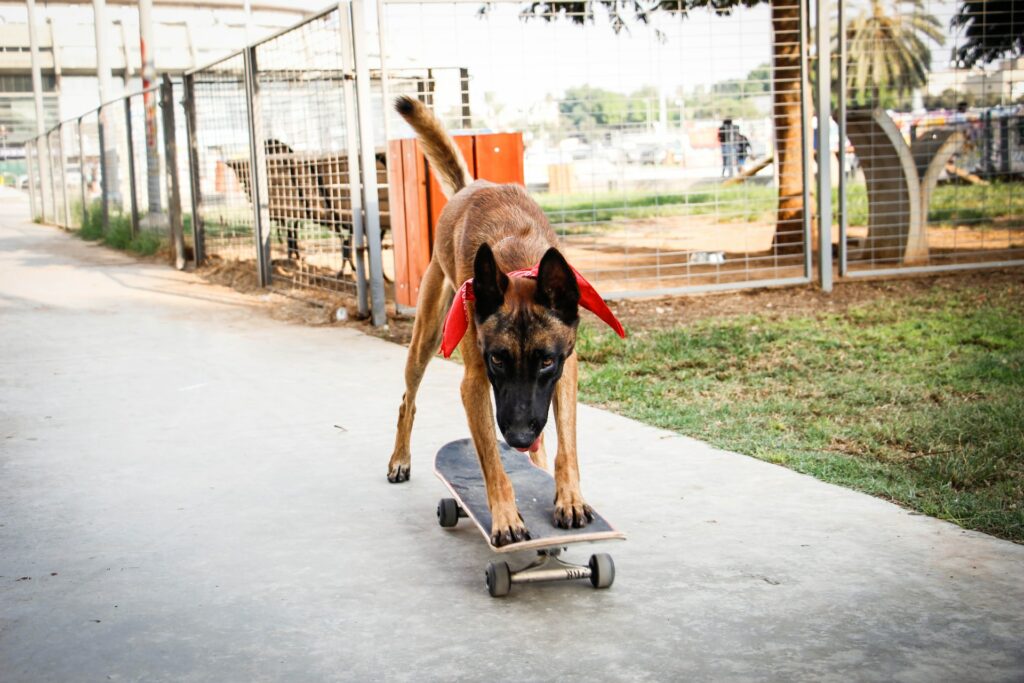
It might take a while to get this step to the point that they don’t jump on by themselves. That’s normal and really to be expected. However, you need to have patience and praise them for the time they do spend on the skateboard.
Teach a Command
The next step in teaching your dog how to ride a skateboard is to introduce a command or cue word. Pick a word to use to tell your dog to jump onto the skateboard. Practise it with them, until whenever the word is said they hop on and expect a treat. This should teach them to do the trick on command. Continue to occasionally push the skateboard during this step. Once they’ve mastered the command they should be relatively comfortable with the skateboard moving too.
Build Up Distance
Once your dog has mastered all of the basics, you need to get them used to actually riding the board, not just posing on it! Increase the distance that you push the skateboard for, building it up until your dog is comfortable being pushed quite a distance. This will get them used to using the skateboard for more than just one push.
Teach Them to Push It
This step is probably the most difficult, getting your dog to actually push the skateboard on their own! If you’ve taken your time with all of the previous steps, your dog should now be quite happy to stand on the skateboard on command, even as it moves. If during this your dog puts a paw on the floor, you should praise them. Gradually they should be able to figure out how to push themselves with this paw.
This step is kind of tricky, and a lot of it comes down to congratulating your dog for an accident! Even if they only push slightly with their leg, positive reinforcement will teach them how to repeat this trick.
Something to keep in mind during this step is that you should stay close to the skateboard at all times. This is for your dog’s safety and their reassurance. They will feel more comfortable learning to push for themselves if they’re sure you’re within distance to catch them if they ever take a tumble!
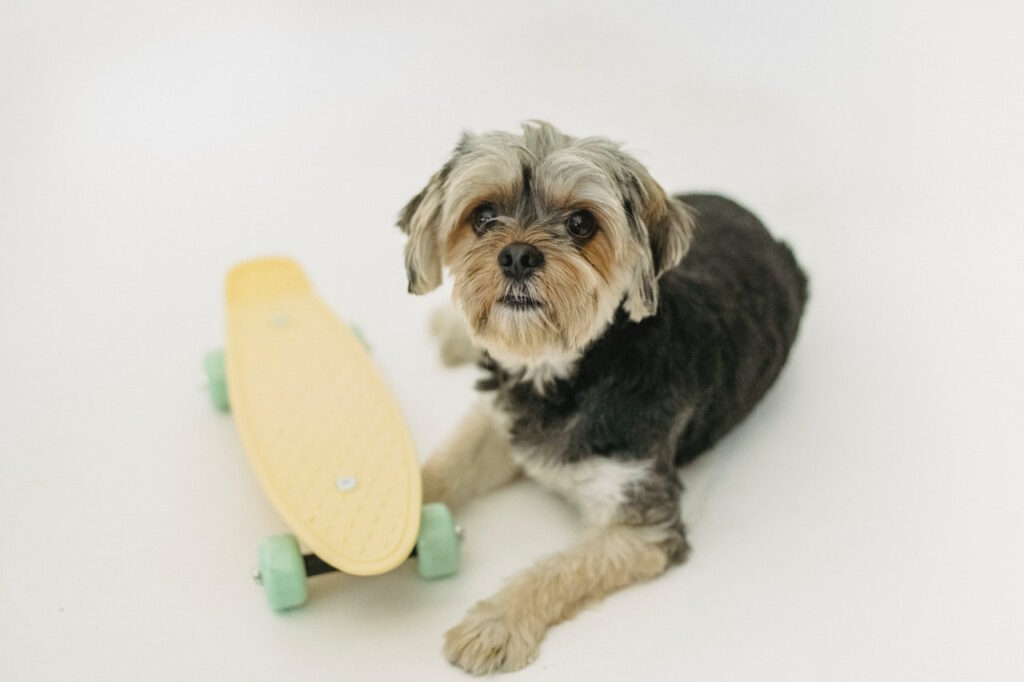
Safety When Teaching Your Dog How to Ride a Skateboard
Teaching your dog how to ride a skateboard is a bit of a long process, and it has a few more difficulties than teaching them to sit! You will need to take some safety precautions if you want to make sure your dog doesn’t have any accidents. These are some things to keep in mind when training:
- Dog Size and the Skateboard – The skateboard you use for your dog is going to vary depending on the size of your dog. A small dog won’t be able to get a leg off the side of a normal sized skateboard while standing in the middle of the board. Equally, a big dog might be too long to comfortably fit on a regular board. Make sure you’re using something that is sized appropriately such as a longboard.
- Where to Train – When you’re teaching your dog, make sure it is in an appropriate area. At first, stick to places where they won’t get hurt if they come off the skateboard. This is especially the case when they’re first learning to push and balance on it.
- Their Paws – Watch your dog’s paws when training for any longer period of time. The grip tape on a skateboard is designed for skate shoes, not for dog’s paws! It can be irritating over a longer period of time. You should also make sure they’re not pushing for too long. Tiring out only one leg at a time could become a problem on walks.
Teaching your dog to ride a skateboard can be a fun experience for you and your pet. This is a longer project. However, if you take the right safety measures and have some patience, you should be able to teach your dog this cool trick!







